Samsung Galaxy Note 20 Ultra Review
Samsung's new flagship is one of the best available
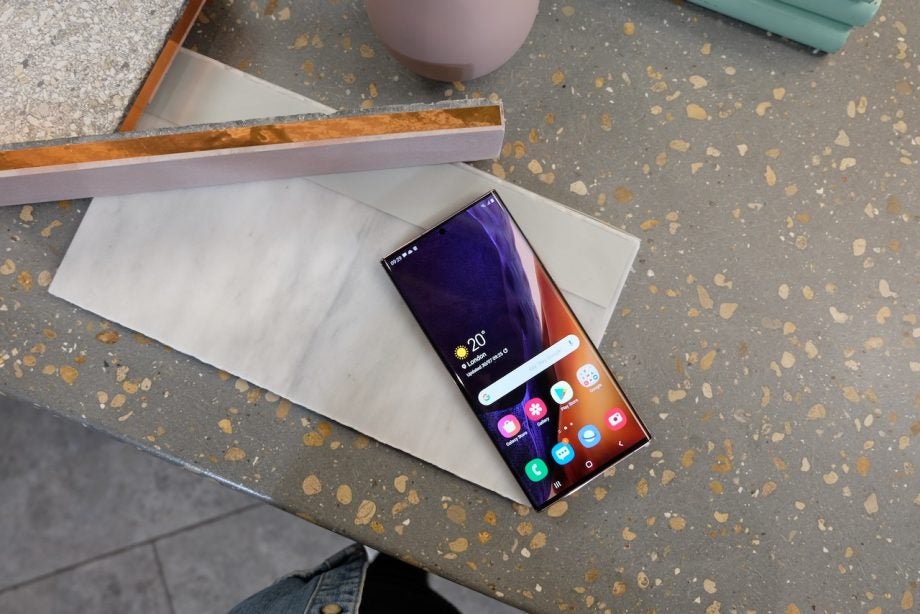

Verdict
The Galaxy Note 20 Ultra cements Samsung’s place as one of the best phone makers in the world delivering a stunning display, great camera and a wealth of S Pen productivity perks
Pros
- Bronze colour is really nice, and adds a matte finish
- S Pen even more responsive than ever
- Really good triple camera
Cons
- Battery life, on Exynos version, isn’t good
- Screen resolution limits are annoying
Key Specifications
- Review Price: £1179
- Android 10
- 6.9-inch, OLED, 120Hz Adaptive Refresh rate screen
- Exynos 990 or Snapdragon 865+ CPU depending on region
- 108MP main, 12MP telephoto, 12MP ultrawide tri-sensor rear camera
- 4500mAh battery
The Samsung Galaxy Note 20 Ultra is here, and it’s a phone with so much going on – some of it works, other parts don’t.
If any phone was deserving of the term super flagship, then the Note 20 Ultra is that phone. Everything here is amped up, from the screen to the camera. Or at least, it is on paper.
The price is amped up too and this is one expensive device, though it seems far better value when compared to the severely lacking Galaxy Note 20.
- Here’s everything we know about the Samsung Galaxy S21
But, has Samsung done enough to make this its best phone of the year? Or is the S20 series still the go-to choice? There’s also 2021’s Galaxy S21 range to consider now. If you love the Note series, the S21 Ultra with its 120Hz refresh rate and S-Pen support is the one the watch. Keep an eye on Trusted Reviews to see our review when it goes live.
The Samsung Galaxy Note 20 Ultra will come in three colours (Mystic Bronze, Mystic Black and Mystic White), with prices starting from £1179. There are a number of pre-order incentives, including free Galaxy Buds Live.
You can pre-order now with the release date on August 21.
Related: Best Samsung phone
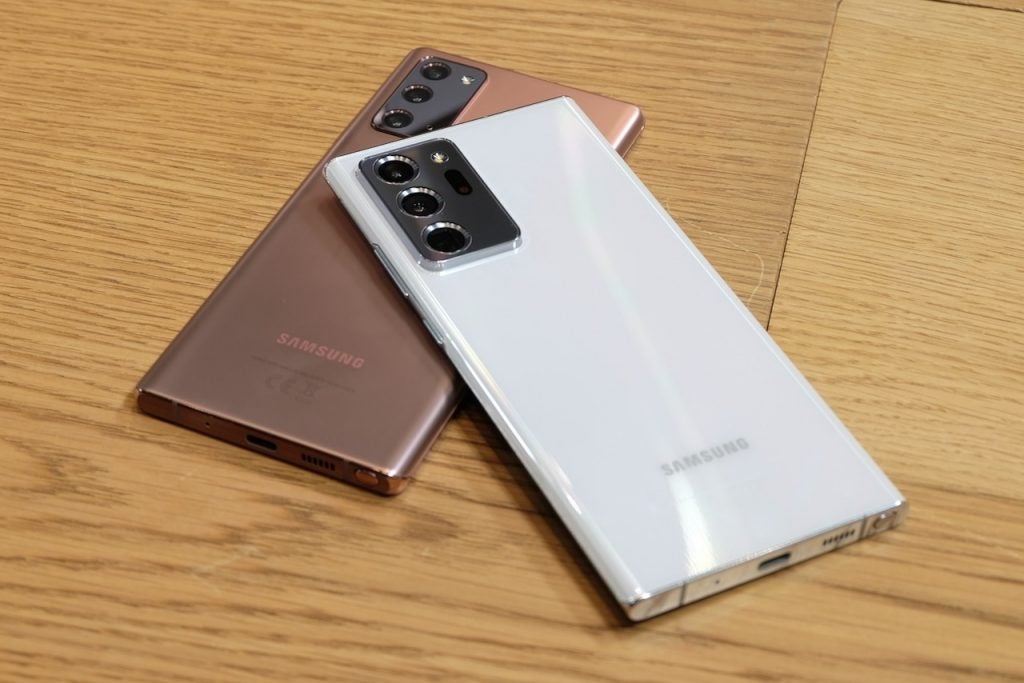
Battery life and screen – The big talking points for the Note 20 Ultra
It’s very rare that we’d ever kick off a review talking about battery life, but for a modern phone like this, exactly how long it lasts is intrinsically linked to the display.
The Samsung Galaxy Note 20 Ultra is the first phone I have used that packs a variable refresh rate screen, speeding things up to 120Hz when scrolling or playing compatible games and then dialling it down to as low as 1Hz when you’re reading something static. There have been lots of 120Hz phones this year, but they all stay at that high level all the time, even when zero benefit is offered.
By reducing the refresh rate at certain times the display has less work to do, and should result in better battery life. Or at least that’s the idea…
I’ve been using the Note 20 Ultra for the past 10 days, a surprisingly extended period to get a good idea of how long the battery lasts and whether the new screen actually makes much of a difference. First off, you can’t tell when the screen changes refresh rates and it’s incredibly smooth all the time. Secondly, you still can’t have it set to 120Hz and WQHD+ at the same time – if you want the smoothness you’ll have to make do with FHD+. This is such a shame and while the 1080p resolution is great, when you pay this much for a phone you want to use everything to its fullest.
I’ve been just about getting through a day with the Note 20 Ultra, but I wouldn’t say battery life is great. An average of 5-6 hours of screen-on time (with some days even down to as low as 3-4) isn’t up there with the best and you won’t be pushing multiple days unless you’re using it sparingly. Of course, there are ways to get more from a charge. Lower the screen brightness, lower the resolution or stick to 60Hz – but who wants to do that? That’s not what the Note series is about.
Maybe the battery life isn’t that much of a surprise, especially when you consider the battery is notably smaller than the cell inside the Galaxy S20 Ultra at 4500mAh. My review unit is also powered by the Exynos 990, rather than the Snapdragon 865+ North America gets, and these Exynos phones tend to perform worse when it comes to endurance than the Qualcomm counterparts.
Interestingly, Samsung has removed support for 45w charging, citing lack of demand for its sold separately charger. Instead, charging tops out at 25w and a full charge takes about 90 minutes (or 80 with the phone turned off). 15w wireless charging is supported too if you have a capable Qi pad.
Still, the large 6.9-inch Super AMOLED display itself is excellent. It’s ridiculously bright to the point where using it outdoors on a sunny day is a doddle. It’s also the most capable phone I have tried yet at playing HDR content, with a real noticeable difference over SDR. Colours are rich, blacks deep and viewing angles only marginally affected by the sloping sides.
Related: Best phone
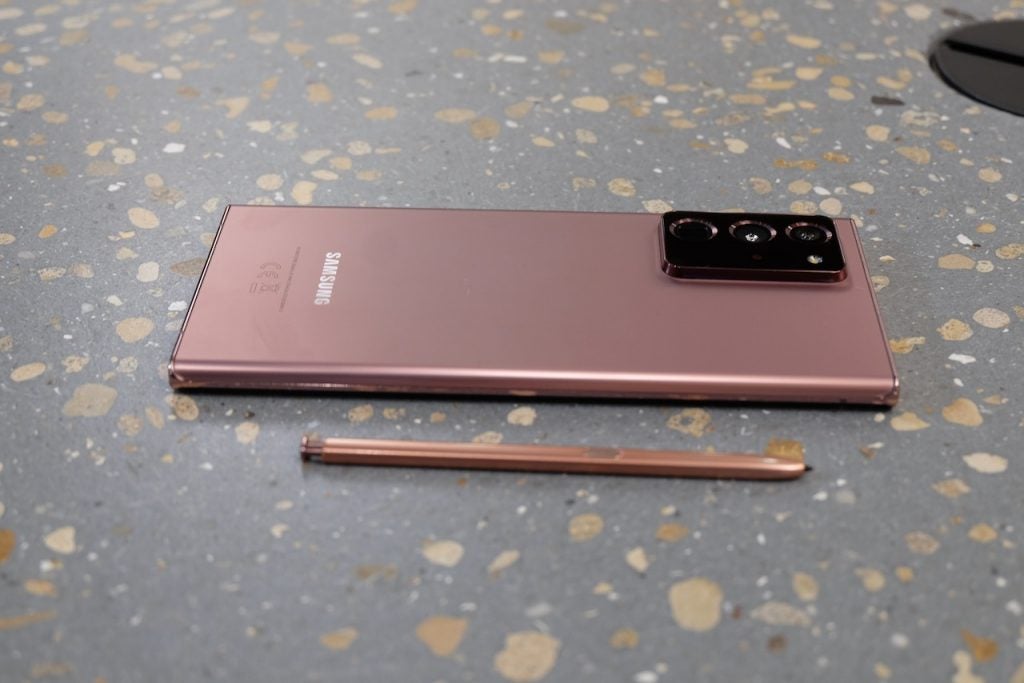
Design – Samsung is back to its best
After something of design blunder with the dull Galaxy S20 Ultra, Samsung is back to its best with the stunning Note 20 Ultra. I’ve been using the Mystic Bronze model and it’s immediately one of my favourite phone hues. It’s not gaudy like other golds, has a slightly darker tint on the (huge) camera bump to offer contrast and extends to the S Pen too. Picking up the bronze version also gets you a smooth matte finish on the back, rather than a glossy one. If you go with the black hue though you will still have a glossy rear.
I’ve always preferred the look of the Note to the S series. It has a far boxier, squared-off look that remains very distinctive.
The large camera bump is likely to cause plenty of debate – but I like it. The rectangular hump houses three cameras, a new autofocus model and flash, and it does stick out a fair bit. If you like typing when your phone is on the table then prepare for a lot of bouncing around.
The Note 20 Ultra is a big phone, even when compared to other big phones like the iPhone 11 Pro Max. It actually made me pick up the iPhone and think it was small – which it certainly isn’t.
This is par-for-the-course with Note phones and one of its distinctive traits. It’s weighty too, though the curved back helps it rests nicely in your hand. There’s a USB-C port on the bottom, the S Pen has switched sides from its traditional spot and there’s a SIM/expandable slot on the top. An IP68 rating for water resistance remains.
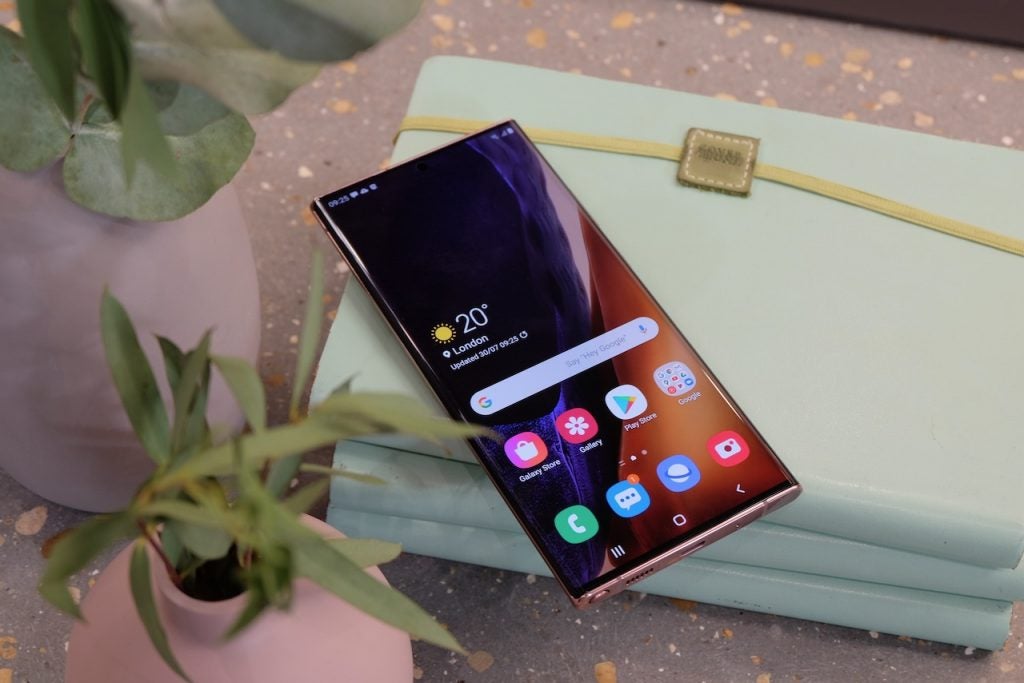
Performance and S Pen – Is the UK getting a duff deal with the Exynos 990?
A lot of people get very annoyed about the differences between the UK and North American Note devices. Here in the UK Samsung ships its phones with its own Exynos chipsets, while the other regions get the usually superior Snapdragon model.
It’s the same here, with my version powered by the same Exynos 990 as the S20 series, while the North American version ships with the newer, and faster, Snapdragon 865+. I know Samsung wants to keep selling phones with its own chips, but this is an odd way of doing it.
Aside from the battery issues mentioned above, the Exynos 990 is still very fast – but then I don’t have the 865+ to compare. This Note 20 Ultra benchmarks similarly to the S20 series and performance feels very similar – everything is quick to open, games play fantastically well even on the highest settings and multitasking is smooth thanks to the 12GB of fast RAM.
The S Pen has always been the thing that made a Note phone a Note phone. The stylus is better than ever here, with latency cut from over 40 to 9ms to make it super smooth responsive. I’ve also found the S Pen to be something of a gimmick: I’d use it a bit, then forget it was there. The screen, to me, still feels too small for meaningful drawing or note-taking and the Air Gestures are more faff than they should be. But, I know people who love the S Pen and for those the benefits here will make this a fantastic upgrade.
Samsung has improved many of the surrounding aspects of the pen too, with the dedicated Notes app now (finally) allowing you to sync your jots and doodles with other services thanks to Office 365.
This is a 5G phone, supporting all the versions of 5G across the globe, along with the usual array of 4G, 3G etc networks. Call quality is excellent and the speakers are good too, with sound coming from both the top and bottom. Samsung has also stuck with the same in-display fingerprint scanner as the S20 series. It’s fine, but not as fast as a capacitive sensor.
There are a couple of big software tweaks here, though the base One UI is similar to that of the Galaxy S20 and Note 10. Samsung has a partnership with Microsoft for some exclusive Game Pass Ultimate game streaming features like buying DLC, however this doesn’t officially launch until mid-September. Paired with a controller and 5G, I can see this being an excellent on-the-go gaming phone.
DeX can now be used wirelessly if you have a Miracast enabled casting device. This is Samsung’s desktop-like interface that turns the phone into more of a PC and now you don’t need cables to make use of it.
While Samsung’s software has improved immeasurably over the past few iterations, it’s still cramped with dual services. There’s a lot of preinstalled Microsoft apps, plus Samsung’s own browser and so many duplicate apps. Two clocks, two calculators, two app stores – it’s all a bit ridiculous.
Related: Best camera phone
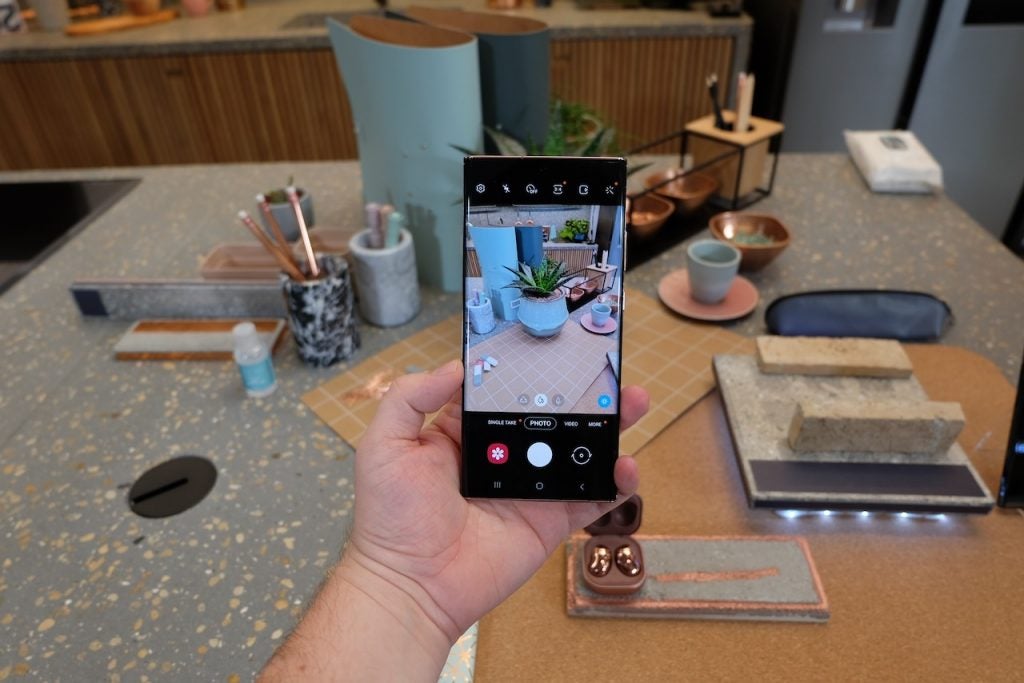
Camera – The Note 20 Ultra is a huge improvement over the S20 Ultra
The camera system here is very capable and if you’re a fan of Samsung’s rich colours, detailed images and social-media friendly look then you’ll feel right at home. With the addition of the new focussing sensor, the biggest issue from the Galaxy S20 Ultra has been resolved.
You’ll take the majority of your snaps with the main 108-megapixel sensor which, by default, brings multiple pixels together to give you brighter 12-megapixel images. Or you can shoot at the full 108-megapixel resolution – just don’t expect these to be easily shareable due to their large sizes.
Images are so colourful, with punchy blues and saturated hues that pop off the ridiculously bright display. Pretty much every picture I took, whether in bright conditions or in lower-light environments was usable and the new focussing sensor locks on to targets very quickly. Dynamic range is excellent, with a strong difference between the lightest and darkest points, and you can have nice silky, natural bokeh even without using the Live Focus mode.
Speaking of modes, there’s a lot going on here. Single Take bunches pictures and video together to create short gifs and there’s AR and Bixby features aplenty. There is a dedicated Night mode, but I found this to fall short of similar modes you’ll find on Huawei, Apple and Google phones. Still, it’s there if you want to inject your bar shots with extra light.
There’s also both a 12MP ultra wide and a 12MP telephoto with some clever periscope glass over it that allows for very good 5x optical zoom. Samsung has done a great job at matching the colours between all three camera sensors, meaning whichever focal length you choose there’s a sense that they’re all coming from the same place.
Samsung has ditched the wild 100x zoom from the S20 Ultra and it now maxes out at 50x, which should only be used to show off how far your phone can zoom. Stick to the optical 5x and you’ll get truly excellent zoom shots that don’t have any of the usual artifacting you’d find with digital zoom. The 10MP front camera is great too.
Whether this is the best camera phone out there really comes down to your personal preferences. For me, I still prefer the slightly less bombastic colours you’ll get with a Pixel or iPhone 11 Pro – but the secondary cameras are far better here, so you’ll see variety in the types of shots you can get.
My only real qualm is the amount of haloing you get around straight lines. Take a picture of a building and they’ll always be an unsightly white line around details when you zoom in. You likely won’t notice it until you look for it, but then it’s hard to ignore.
The video recording features are excellent on the Note 20 Ultra, with ‘cinematic’ 8K 24fps showing just how good these phones have become at capturing footage. If you lower the resolution you’ll get handy extras like focus tracking.
You can see a selection of photos taken on the Galaxy Note 20 Ultra below.

Colours, pop, detail is great (if it little oversharpened) and dynamic range is on point

Thanks to the periscope lens, you can get great shots of subjects far away

Skies look great and though this is at 10x, there’s still load of detail
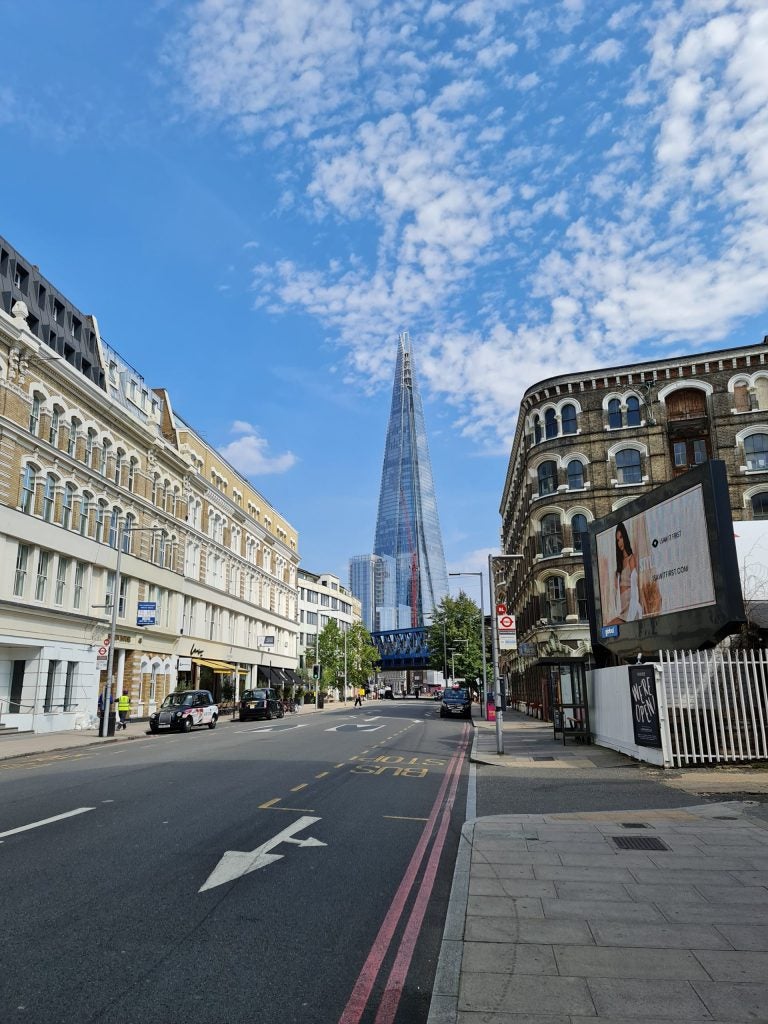
Ultra wide: Samsung manages to keep colours looking similar across all three cameras

Colours have a real strong pop
Related: Best phablet
Should you buy the Samsung Galaxy Note 20 Ultra?
The Note 20 Ultra is big, brash and expensive with specs for days and a bevy of inventive additions that show Samsung remains up there with the best when it comes to Android phones. The camera is great, the S Pen much improved and the screen a joy. This is the full-on Note experience, amped up to 11.
But, there are issues. Battery life is far from great and being forced to sacrifice resolution for smoothness is a shame – even if this would affect the battery even further. The UK not getting the Snapdragon version also means there’s no noticeable speed or graphics boosts over the S20 series.
Still, if it’s the S Pen and huge screen you’re after then the Note 20 Ultra is for you.


